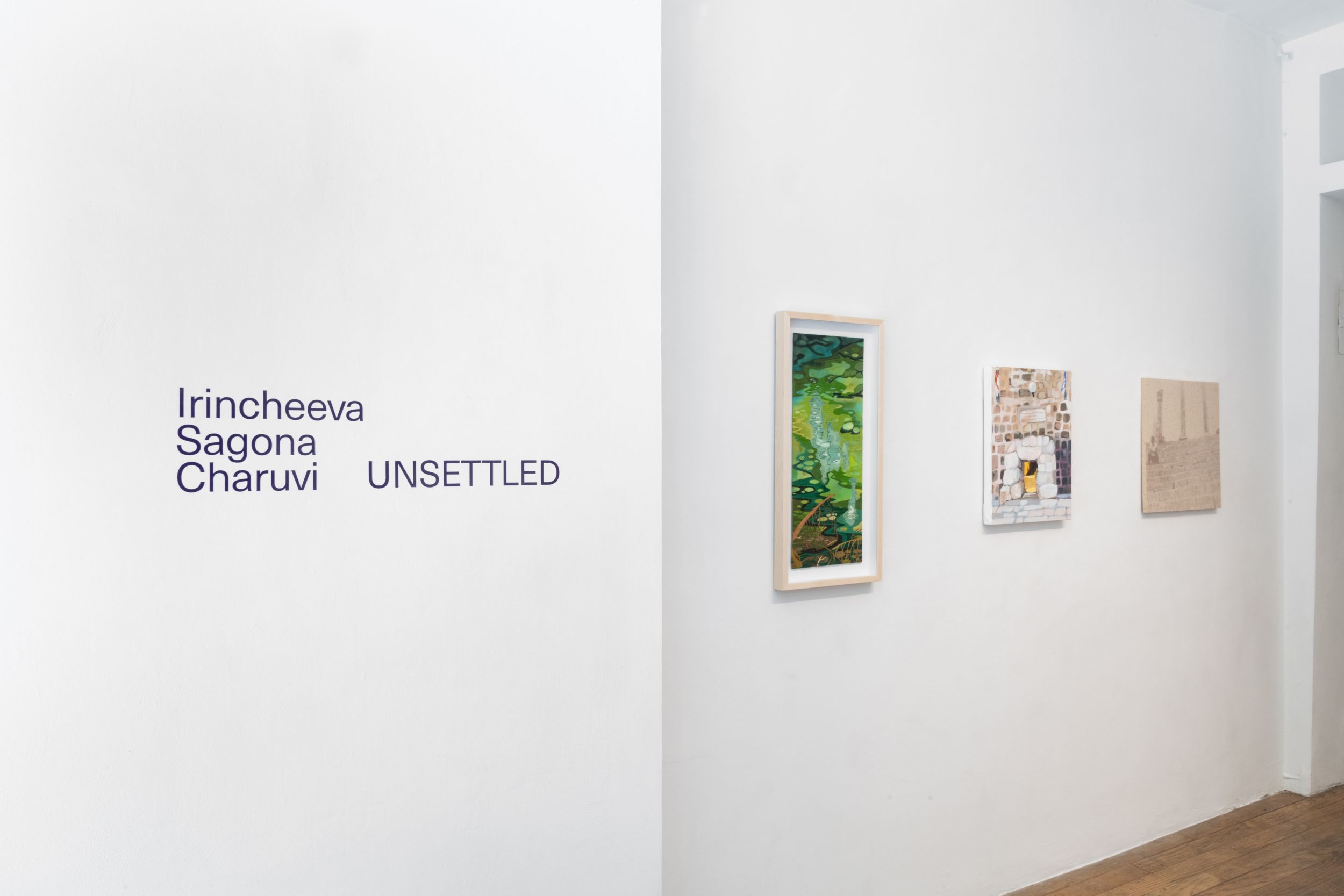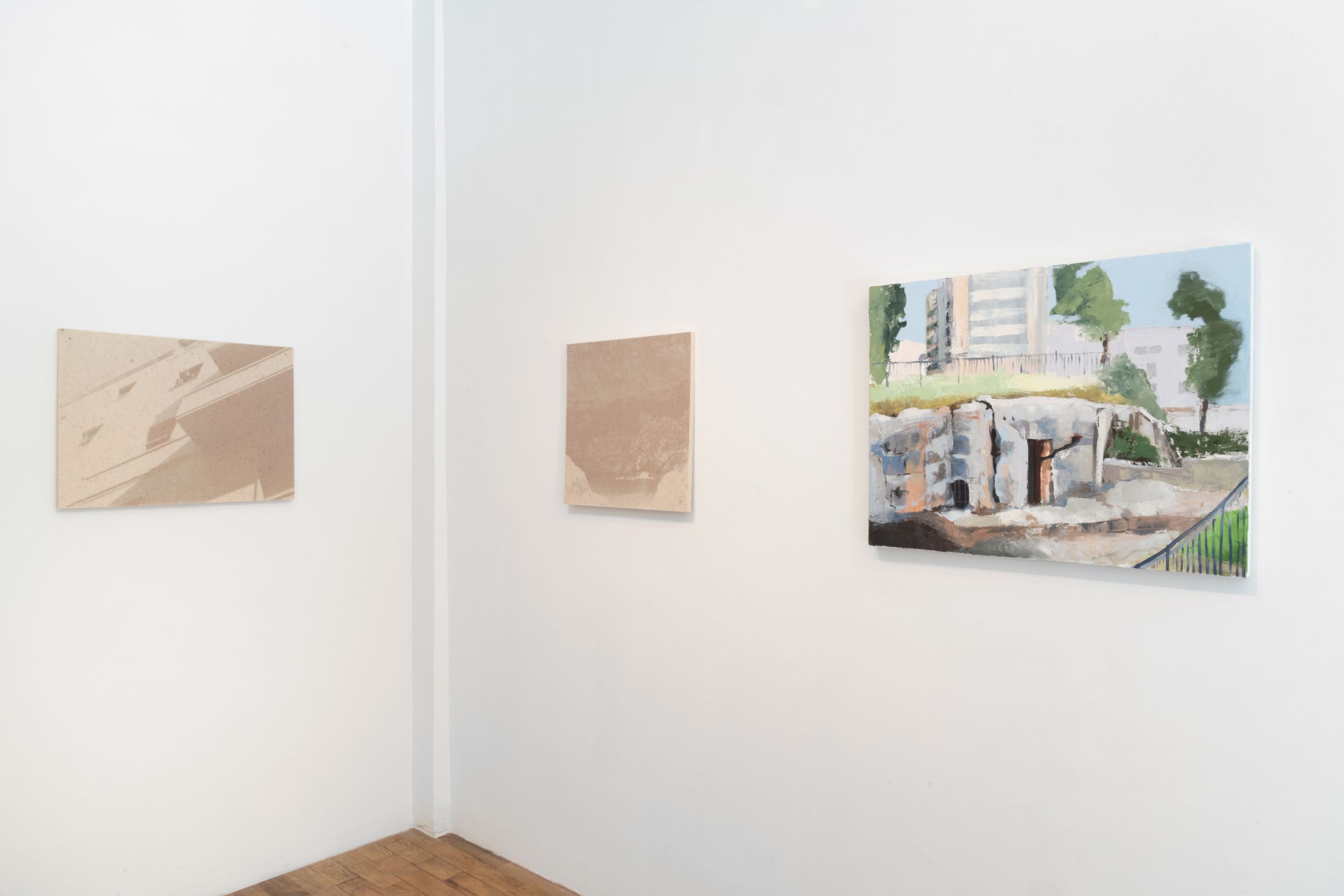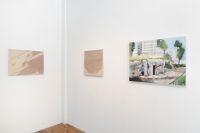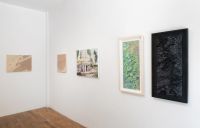Unsettled
June 16, 2022–July 17, 2022
This exhibition, featuring the artists Daria Irincheeva, Marina Sagona, and Noa Charuvi, explores the themes of memory, heritage, and the invaluable comfort of home. Irincheeva (Russian-American), Sagona (Italian), and Charuvi (Israeli), all live in New York and their work explores the legacies of family and country through depictions of landscapes.
The artists each explore their personal relationship to land; whether it be the Italian colonies in Libya, the more recent invasion of Ukraine, or the ongoing conflict between Israel and Palestine, the artists explore personal traumas and internal conflicts as the consequences of political and religious forces.
Irincheeva, Sagona, and Charuvi draw attention to the ways these imperial powers — their home countries — operate opportunistically for the benefit of the State–but not for their people.

Based in NY since 2011, but regularly moving between her native St. Petersburg, Russia; Santiago, Chile; and Vienna, Austria; in 2020 Irincheeva returned to NY and began making landscape embroideries, prior to the COVID-19 lockdown. She learned to embroider from her maternal grandmother, and uses this meditative technique to reflect on those places she’d lived and traveled. During her time abroad, Irincheeva spent many hours in nature, recording her surroundings. These are what she used as references for her embroideries; the ripples and reflections on water: hypnotic and relaxing.
In late February, when Russia invaded Ukraine, Irincheeva no longer felt that she could exhibit the idyllic landscapes she had previously made. Her diptych titled, Bucha 1/22, Bucha 3/22, is the artist’s interpretation of the river that runs through Bucha, before and after the atrocities that took place there. It’s a reflection on the devastation caused by Russian forces, the terror that was inflicted on the people who live there, and the aftermath as it was witnessed by the larger world.
Bucha, a town near Ukraine’s capital, Kyiv, was known as a place inhabited by the creative class, and to city dwellers what the Hudson Valley is to NYC. The losses inflicted on the city following its occupation, between February 27th and March 31st, will take years to repair, and the horror and trauma that its residents experienced mean they will never again view it as the peaceful retreat it once was.
Irincheeva, in her diptych, forces us to reconcile with the thought that no matter how safe we feel, terror and destruction could wipe away our homes and those places that provide a sense of comfort.
Marina Sagona is an Italian artist based in New York. She has been working on a series, “The heritage of the father,” which includes videos, sculptures, and mixed media works. The series explores the story of her father and his family and stems from Jacques Lacan’s sentence: "To be able to go beyond the Father one needs to acknowledge their own origins”.
The paternal side of her father’s family had lived in Libya since the 1700s, and came from Malta during the Ottoman Empire. The maternal side came from Sicily during the Italian colonization of Libya to reap the benefits Mussolini gave families for moving there. In 1969, under the leadership of Gaddafi, all Italians and Libyan Jews were given a 24 hour period to flee Libya; her father and his family spent many months in refugee camps before settling in Rome, where Sagona was born and raised. To “return” to Italy after making Libya their home was devastating, and stories of this abrupt departure followed Sagona throughout her childhood. As refugees, her father and his family always expressed their longing to go back to Tripoli, a place that became synonymous with an unrivaled utopia, while in fact the reality there was dictatorship, war, and poverty.

The images that are printed on felt in this exhibition are details of photos from Sagona’s family archive. They were taken in the 60s in and around Tripoli. The Oasis is a recessed place of respite, a natural giant well in the middle of the desert where two little figures (the artist’s father and his brother) are swimming. Sciara Beirut meaning Beirut Street depicts, in an almost abstract way, the building where Sagona’s family lived in downtown Tripoli. Leptis Magna, one of the most beautiful cities of the Roman Empire is now an archeological site outside the city of Homs, 81 miles east of Tripoli. The ruins, where Sagona’s father is depicted sitting more than sixty years ago, are still among the best-preserved Roman sites in the whole Mediterranean, due to the total lack of tourism since Gaddafi’s coup in 1969.
Sagona chose to print these images on felt because the material, wooly in nature, gives back the idea of a place wrapped up in the blurry nature of memories, and obscures the images as if you were viewing them through a gust of wind carrying sand across the desert.
Noa Charuvi has been painting landscapes for many years. The paintings included in this exhibition are part of a series called the Charuvi Landscape Project. Charuvi’s paternal grandfather, Shmuel Charuvi, whom she never met, was also a painter. He immigrated to Israel from Odessa Ukraine, to escape antisemitism and joined an art school in Jerusalem to pursue landscape painting. Charuvi grew up with these paintings strewn across her home, a constant reminder of a man she never knew.
In 2019, before COVID-19 upended our lives, Charuvi went home to Israel to collect her grandfather’s paintings as material to work from. She listed all the places he painted, to the best of her ability, and visited those places to take her own photographs as references. In doing this she was able to compare how her grandfather viewed these sites with how she sees them; her grandfather painted sites around Israel that Charuvi assumes he thought were important. He may have also been painting them to sell to tourists. When she visited the sites she found a few different things; Palestinian villages were no longer standing. Some rubble and stones scattered near a newly constructed playground could be all that remains of the houses her grandfather painted, and it was clear that conflict and violence had reached this corner of Jerusalem long before her visit. Rachel’s Tomb is another site that Charuvi visited: completely fenced off and guarded by Israeli Border Patrol, she didn’t feel comfortable visiting the tomb and left shortly after arriving.

Tombs of the Judges, also known as Tombs of the Sanhedrin, is another site she visited. It’s located in Sanhedria, a Hasidic neighborhood in northern Jerusalem. It’s an Ancient Roman burial site from the 1st Century CE although it is believed to house the bodies of the Judges of Israel, a group of people who upheld God’s law during the period between 1398 and 1050 BC. As a secular Jew, Charuvi felt unwelcomed in these more conservative enclaves and had never visited this neighborhood. She noticed that the tombs were littered with trash and graffiti, obviously not conserved to the standard that most important public sites are.

Her second painting is an entrance to The Monastery of The Cross, close to where she grew up in Jerusalem and located in the Valley of The Cross. Again, she visited the chapel for the first time for this series. It’s controlled by the Greek Orthodox Church, to which she has no ties. Her grandfather often came to the Valley of the Cross to paint, as it was not far from his studio and it had many beautiful nature scenes that served as inspiration for other paintings. Charuvi notes that his compositional choice for this painting is curious, as it is only a portion of a much larger structure–but given its religious significance to Christians, it may have been one of the paintings he intended to sell to the Christian tourists visiting Jerusalem. Luckily, it stayed in the family and is now one of many paintings that are part of the Charuvi Landscape Project.
About the artists:
Marina Sagona is an Italian and American artist working in a variety of media whose practice explores the concept of control, addiction, and familial relationships.
In Rome, she was assistant to postmodern artist Mario Schifano and studied Art History at the University La Sapienza. In New York, she started her career drawing for The New Yorker and the New York Times.
Marina Sagona is the recipient of the 2017 Strategic 50 Award, the 2019 Domus Artist Residency in Galatina, Italy, and the 2021 Chiquita Gallery Residency in Barcelona, Spain.
In 2022 she was awarded the Cadence Video Poetry Festival Prize for her film Stabat Mater.
In 2014 she co-curated the exhibition “Dante Ferretti: Design and Construction for the Cinema” at MoMA. From 2006 to 2008 she directed the contemporary department of Fiac (Foundation for Italian Art and Culture). In 2008 she collaborated with Alanna Heiss on the exhibition Senso Unico at MoMA PS1. Her most recent solo exhibition of her series, Couscous, took place at Chiquita Room Gallery within the frame of the Loop Festival in Barcelona in 2021.
Born in Israel and based in New York City, Noa Charuvi holds an MFA Fine Arts from the School of Visual Arts in New York and a BFA Fine Arts from the Bezalel Academy in Jerusalem. Noa was a recipient of The Pollock Krasner Foundation Grant for 2018-19. Residency programs she has attended include: Art Omi International Artists Residency in Ghent, NY, Yaddo artist colony in Saratoga Springs, NY and The Keyholder Residency at the Lower East Side Printshop in Manhattan. Her work was exhibited internationally, in venues such as The Bronx Museum of The Arts (New York), Haifa Museum of Art and Mishkan Museum of Art, Ein Harod (Israel). Recent one-person shows featuring Noa’s work took place in H Gallery in Paris and Art100 in New York. Publications include "Landscape Painting Now", an anthology of contemporary painting published by D.A.P and Thames & Hudson. In late 2019 Noa was a recipient of a travel grant from Asylum Arts and a studio grant from FST Studio Projects Fund.
Daria Irincheeva is a multidisciplinary artist, whose practice currently consists of working with sculpture, painting, video, textile and embroidery. Through such media, Irincheeva explores the processes of language, history-construction, memory-colonization, information-fossilization, temporal repetitions, and dead-ends in time. Irincheeva received her BFA with Honors from the School of Visual Arts, New York in 2013; and her Masters in Fine Arts from Columbia University, New York in 2018.
Her work has been exhibited at the Moscow Museum of Modern Art, Venice Biennial, Kunstraum Niederoesterreich, UncleBrother/Gavin’s Brown Enterprise, Museum of Modern Art of Bologna, Postmasters Gallery; among others. Irincheeva participated in the following art programs and residencies: 2017 Whitney Biennial program “Counter-commencement debtor's assembly”; the program of the Jewish Museum, New York "In Response. The Arcades" in 2017; AZ West “Institute of Investigative Living” residency, CA, USA, 2017; and the New Museum Seminars “Legacy”, New York, 2016.
Irincheeva lives and works in upstate New York.
Opening Reception:
June 16, 5–8pm
191 Henry St
New York, NY 10002










